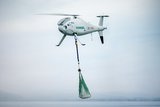Northrop Grumman's Hunter Unmanned Air System Successfully Complete GPS-guided Viper Strike Testing
Northrop Grumman Corporation's Hunter Unmanned Aircraft System (UAS), in use with the US Army since 1996, has successfully completed testing of the new GPS-guided Viper Strike (VS) weapons system at White Sands Missile Range, N.M. GPS VS will soon deploy to theater on board Hunter in support of contingency operations.
GPS VS aides the weapons guidance by providing proximity based on coordinates while maintaining pinpoint accuracy with laser guidance.
While previous VS systems required the Hunter to be directly overhead GPS VS offers the advantage of nearly six miles of stand-off range. GPS VS can also hone in on both moving and stationary targets.
The MQ-5B Hunter, which is currently deployed in contingency operations, provides warfighters with state-of-the-art reconnaissance, surveillance, and target acquisition (RSTA), communications relay, signal intelligence, and weapons delivery. Hunter recently surpassed 80,000 flight hours, 53,000 of which are combat-related.
"Once again, Northrop Grumman and the Army have proven just how adaptable Hunter is, which is why we call it the Army's workhorse," said Karl Purdy, Northrop Grumman Technical Services' Hunter program manager. "The addition of this improved smart munition with a proven aerial platform is just one example of Hunter's flexibility and adaptability. We are committed to working shoulder to shoulder with our valued Army customer to continue to provide our nation's warfighters with world-class ISR and signals intelligence."
The RQ-5A Hunter was the Army's first fielded UAS. The MQ-5B is the next-generation Hunter, continuing a legacy of service to Army corps, division and brigade warfighters. Flying over the battlefield with its multi-mission optronic payload, the MQ-5B gathers RSTA information in real time and relays it via video link to commanders and soldiers on the ground.
The MQ-5B Hunter is distinguished by its heavy fuel engines, its "wet" (fuel-carrying) extended center wing with weapons-capable hard points and a modern avionics suite. The MQ-5B Hunter system uses the Army's One System ground control station and remote video terminal.
It also carries a communications relay package to extend the radio range of warfighters. A differential GPS automatic takeoff and landing system was recently fielded to the UAS Training Battalion in support of Hunter training.
"For more than a dozen years the Hunter Unmanned Aircraft System has been the most versatile tool in the Army UAS inventory, undergoing continual upgrades and improvements to meet the needs of the warfighter more effectively in several theaters of war," said Col. Greg Gonzalez, Project Manager for the Army's Unmanned Aircraft Systems.
"The integration of the GPS Viper Strike on the Hunter is the most recent example in a long list of rapid integration efforts made on that system to better support our soldiers in combat and give them the tools they need to succeed."
The MQ-5B features a robust, fixed-wing, twin tail-boom design with redundant control systems powered by two heavy fuel engines - one engine to "push" and another to "pull" the air vehicle. Another Hunter capability is its relay mode that allows one Hunter to be controlled by another UAV at extended ranges or over terrain obstacles typical of those found in the Balkans and Afghanistan.
Hunter's toughness and reliability are unmatched as it maintains an operational readiness rate over 95 percent in operational theaters.
It is an ideal platform for spiral enhancements and technology refresh payloads. Recently Northrop Grumman integrated a new suite of avionics for Hunter, including upgraded flight and mission computers, an auxiliary power distribution unit, the LN-251 inertial navigation system with GPS, a downsized data link system, and an APX-118 IFF transponder.
The avionics suite improves performance by reducing size, weight, and power consumption of the equipment used to control the aircraft and manage its critical subsystems.
More from Uncrewed Vehicles
-
Jammer resistant drone designs spark search for countermeasures
The Russia-Ukraine conflict has driven another stage of evolution for drones and the counter measures to defend against them.
-
![L3Harris launches Amorphous software for control of uncrewed platforms]()
L3Harris launches Amorphous software for control of uncrewed platforms
The new Amorphous software is a universal controller that would allow a single operator to control a swarm of “thousands” of uncrewed systems, from drones to underwater platforms.
-
ideaForge unveils new UAVs at Aero India 2025
India UAV supplier ideaForge has launched the Netra 5 and Switch V2 drones at Aero India 2025, boasting of enhanced endurance, AI-driven autonomy and improved operational capabilities.
-
![Shaping the future of defence: What 2025 holds for the global drone market]()
Shaping the future of defence: What 2025 holds for the global drone market
The UAV market is experiencing unprecedented growth, with innovations in technology and battlefield applications driving demand across military sectors. From the battlefields of Ukraine to NATO exercises and beyond, drones are transforming how wars are fought and supported.
-
![Maris-Tech confirms customers signing up for Jupiter Drones codec and AI-powered system]()
Maris-Tech confirms customers signing up for Jupiter Drones codec and AI-powered system
Launched at AUSA in October, the company’s multi-stream video codec is attempting to bring a new lease of life to drone technology through its AI accelerator.
-
![AUSA 2024: Quantum-Systems targets big 2025 with UAS developments]()
AUSA 2024: Quantum-Systems targets big 2025 with UAS developments
Quantum-Systems has been upgrading its UAS family, with new versions of the Vector, Reliant and Twister drones set for release throughout 2025.
























